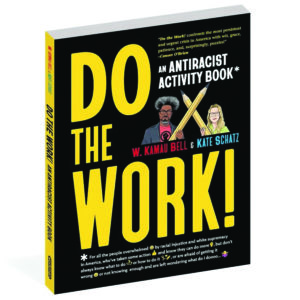Some planted “Black Lives Matter” signs in their yards after the murder of George Floyd. Putting out a sign might be a start to addressing systemic racism, argue W. Kamau Bell and Kate Schatz in Do the Work!: An Antiracist Activity Book, but it’s a place to begin rather than end.

Their workbook seriously and humorously tackles the “what next” problem. Bell brings his warmth, razor-sharp mind, and endless curiosity to most everything he touches. He started in standup comedy and then moved into TV; one critic called his United Shades of America “the smartest conversation about race on television.” This past winter, Bell released We Need to Talk About Cosby, a four-part documentary that won a Primetime Emmy Award for its exploration of Black people’s complicated and painful relationships with the iconic comedian (and serial sexual predator).
Kate Schatz, a self-described “queer feminist mama” who lives in the Bay Area, was Bell’s partner in writing Do the Work! She teaches radical American history and speaks about feminism and antiracism to corporations, including Google and Pixar.
Bell describes the book as a “Racism Sampler Platter paired with a Flight of Ideas for How You Can Take Action.” Its five chapters mix history lessons with quizzes, crossword puzzles, word games, activities, and comics. “And there are jokes!” Bell writes. “Because racism is so hilarious! And coloring pages, because come on, we need some joy, too.”
Bell and Schatz are clear that they’ve written the book for white people, who they believe need to identify and dismantle white supremacy in America. They use the term “white supremacy” to mean “a political and socioeconomic system where white people enjoy structural advantages that other racial and ethnic groups do not.”
The authors take turns providing information and opinions in a format that lends itself to dialogue. Schatz tends to write in a serious voice, while Bell riffs along comedically. She’s a terrific teacher. He is very funny. While Schatz is setting out what white privilege is and introduces a straightforward “check your privilege” list, Bell tosses out categories like “Took a selfie with a cop while storming the U.S. Capitol” and “Am George Clooney.”
Much of the book addresses issues traditionally described as “civics.” Bell and Schatz serve it with a twist. They dive into American history and government in all the ways the far right does not want shared in classrooms. Do the Work! is everything that should be taught and learned.
These two ask hard questions that we all should be able to answer — but likely can’t. Can you draw your Congressional district and show how it evolved over time, or answer questions on Alabama’s literacy test, the gatekeeper of voting until 1965? Me neither.
Bell says that he hated history when he was a kid. Schatz responds that it’s not that people hate history — they hate history class. The two merrily roll along without shaming or blaming. I figured I’d flip slowly through the book, but soon I was filling in blanks, looking up answers on the internet, drawing maps, making lists, and playing games.
I particularly enjoyed the pop-ups. In one, a white woman and child are looking at a police car. The woman says, “The police are helpers who keep us safe!” I lifted up the tab and saw an alternative take: “The job of the police is to help everyone. But unfortunately they don’t always do what they’re supposed to do.”
In another drawing, a white man and white child view the side of a building where someone has scrawled “Justice 4 George Floyd.” “I don’t know why they wrote it,” the man says. “But they shouldn’t have. Graffiti’s against the law.” I pulled up another tab: “They wrote that because they’re angry. George Floyd was murdered by the police.” The pop-ups suggest answers for tough questions. And they made me grin.
The games are also pretty great, especially when Bell’s humor is on display. In “Bootstrapping,” parallel tracks set out spaces on which to move. On one track, a player begins with “Congratulations! Your parents bought boots for you. Skip the whole thing and proceed to the Finish!” The other track of spaces begins with a different set of instructions: “No one ever explained where to buy boots. Skip a turn while you figure that out.”
One could argue that the book is juvenile because it includes these kinds of activities. But the book doesn’t feel like it’s aimed at kids, especially young ones. High school and college students will likely be able to “do the work,” and so will the rest of us.
As for putting up signs, Bell and Schatz don’t dismiss it. For some, they write, posting a message outside your home “is just one part of doing the work. But in some communities, a sign can mark you as a target, and aligning yourself with a cause or candidate can be a risky act. We know this and ask you to be brave. Be public! Show your community what side you’re on.”
As for me, I cut out the sign folded into the book. “End White Supremacy” now adorns my front door.



